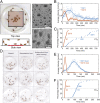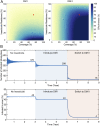A deltamethrin crystal polymorph for more effective malaria control
- PMID: 33046642
- PMCID: PMC7604418
- DOI: 10.1073/pnas.2013390117
A deltamethrin crystal polymorph for more effective malaria control
Abstract
Pyrethroid contact insecticides are mainstays of malaria control, but their efficacies are declining due to widespread insecticide resistance in Anopheles mosquito populations, a major public health challenge. Several strategies have been proposed to overcome this challenge, including insecticides with new modes of action. New insecticides, however, can be expensive to implement in low-income countries. Here, we report a simple and inexpensive method to improve the efficacy of deltamethrin, the most active and most commonly used pyrethroid, by more than 10 times against Anopheles mosquitoes. Upon heating for only a few minutes, the commercially available deltamethrin crystals, form I, melt and crystallize upon cooling into a polymorph, form II, which is much faster acting against fruit flies and mosquitoes. Epidemiological modeling suggests that the use of form II in indoor residual spraying in place of form I would significantly suppress malaria transmission, even in the presence of high levels of resistance. The simple preparation of form II, coupled with its kinetic stability and markedly higher efficacy, argues that form II can provide a powerful, timely, and affordable malaria control solution for low-income countries that are losing protection in the face of worldwide pyrethroid resistance.
Keywords: deltamethrin; epidemiological modeling; malaria; mosquito; polymorphism.
Conflict of interest statement
Competing interest statement: New York University has applied for a patent on the use of form II of deltamethrin with J.Y., X.Z., M.D.W., and B.K. as inventors, to encourage development for malaria prophylaxis.
Figures




References
-
- World Health Organization , World Malaria Report 2019, (World Health Organization, 2019).
-
- Casida J.-E., Michael Elliott’s billion dollar crystals and other discoveries in insecticide chemistry. Pest Manag. Sci. 66, 1163–1170 (2010). - PubMed
-
- Elliott M., Farnham A.-W., Janes N.-F., Needham P.-H., Pulman D.-A., Synthetic insecticide with a new order of activity. Nature 248, 710–711 (1974). - PubMed
-
- World Health Organization , World Malaria Report 2018, (World Health Organization, 2018).
Publication types
MeSH terms
Substances
LinkOut - more resources
Full Text Sources
Other Literature Sources
Medical

